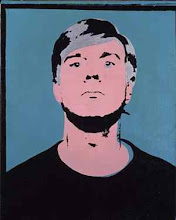 |
| The Fernsehturm and Marienkirche, Alexanderplatz |
Nearby, in Grosse Hamburger Strasse, site of the Jewish Cemetery, is The Missing House by Christian Boltanski. A gap in the houses was created by allied bombing on 3 February 1945. Boltanski has mounted 12 plaques onto the facing walls of the surviving buildings on either side of the gap showing the names, occupations and dates of residency of the people who had lived in the bombed apartments.
Amongst the cobbles of Grosse Hamburger Strasse (and many other streets in Berlin and other cities) are rather wonderful 'Stolpersteine' ('stumbling blocks') - the work of Gunther Denmig. These modest, brass-faced, cobble-stone sized, concrete blocks memorialize individual victims of the Nazis at the places where they lived. In the picture, below, for example, the top right Stolperstein reads "Here lived Wolf Segal, born 1873, deported 1943, murdered in Auschwitz."
Our walk took us to Hackescher Markt from where we caught an S-Bahn to Ostbahnhof which is a short walk from the East Side Gallery, the spectacularly painted 1.3km long remnant of the Berlin Wall.
A ride on the U-Bahn from Schlesisches Tor, and a short walk, led us to the Jewish Museum. Daniel Liebskind's extraordinary extension to the museum was completed in 1999. Liebskind's building appears to be detached from the older buiding to which it is an extension; it also has no visible entrance. Visitors must enter through the old building and via an underground passage - a metaphor for the difficulty of entering into the troubled history represented in the museum. The extension is in the form of a zig-zag - apparently a "dislocated Star of David... that is visible only from the air" (see Jacobson). However, I found that I had little sense of the shape of the building from inside it.
The most dramatic and affecting features are the 'Holocaust Tower' and the installation Fallen Leaves in the 'Memory Void'. You enter the Holocaust Tower through a heavy door and find yourself in a bare concrete space, some 79 feet high, lit only by a narrow window slit; it is cold and dark; the walls converge into a narrow space into which visitors disappear. It is very powerful.
Empty spaces, or Voids, are built into the museum. One of these, the Memory Void, contains an installation called Shalekhet (Fallen Leaves) by Menashe Kadishman: it comprises 10,000 faces punched into steel plates covering the floor, many layers deep. Visitors walk across the uneven surface of faces causing the steel plates to clang. Also very powerful.
A short distance from the Jewish Museum on Lindenstrasse is Galerienhaus a building housing 11 contemporary art galleries. Notable amongst the exhibitions showing at the time of our visit were Friedrich Vordemberge-Gildewart (1899-1962) at Galerie Berinson and a group exhibition, Gathered Fates at Galerie Nordenhake. This latter show, curated by Ignasi Aballi, took its theme from a video by Sofia Hultén, Altered Fates, which is a delightful exercise in pointlessness - we watch the artist select objects or materials from a skip, alter them, and throw them back into the skip.
 |
| Friedrich Vordemberge-Gildewart, Composition No.41, 1927 |
 |
| Friedrich Vordemberge-Gildewart, Untitled, c1924 |
 |
| Friedrich Vordemberge-Gildewart, Composition No.75, 1933 |
 |
| Sofia Hultén, Altered Fates, 2013 |
 |
| Installation view of Gathered Fates at Galerie Nordenhake |
 |
| Ceal Floyer, Garbage Bag, 1996 |
*Special thanks to Jack and Abbie for organising the trip.














No comments:
Post a Comment